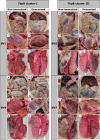TbpB-based oral mucosal vaccine provides heterologous protection against Glässer's disease caused by different serovars of Spanish field isolates of Glaesserella parasuis
- PMID: 39609907
- PMCID: PMC11606180
- DOI: 10.1186/s40813-024-00404-7
TbpB-based oral mucosal vaccine provides heterologous protection against Glässer's disease caused by different serovars of Spanish field isolates of Glaesserella parasuis
Abstract
Background: Glaesserella parasuis (G. parasuis) is the primary agent of Glässer's disease, significantly affecting nursery and early fattening piglets. Current prophylactic measures, mainly serovar-specific bacterins administered to sows, are limited by maternal immunity, which can interfere with active immunization in piglets. Subunit vaccines containing G. parasuis-specific antigenic molecules show promise but are not yet commercially available. Transferrin-binding proteins (Tbp), which enable G. parasuis to acquire iron in low-iron environments like mucosal surfaces, have been proposed as potential vaccine antigens. The mucosal administration of a TbpB-based subunit vaccine could provide a promising solution to overcome the limitations posed by maternal immunity, offering an effective approach to control the disease in weaning piglets. This study, conducted in two phases, primarily evaluates (days 0-45) the immunogenicity of a two-dose oral mucosal TbpB-based subunit vaccine (TbpBY167A) administered to colostrum-deprived piglets, and subsequently (days 45-52), its heterologous protection by challenging these piglets with four G. parasuis clinical isolates from different TbpB clusters (I, III) and serovars (SV1, SV4, SV5, SV7) recovered from Spanish pig farms.
Results: The oral mucosal administration of the two-dose TbpB-based vaccine induced a robust humoral immune response in immunized colostrum-deprived piglets, significantly increasing IgA and IgM concentration 15 days after the second dose (p < 0.01). Upon challenge with four G. parasuis clinical isolates, the vaccine demonstrated heterologous protection, markedly improving survival rates (OR: 8.45; CI 95%: 4.97-14.36) and significantly reducing clinical signs and lesions, regardless of the TbpB cluster and serovar. The vaccine reduced G. parasuis colonization in the respiratory tract (p < 0.0001) and G. parasuis systemic target tissues, like tarsus and carpus joints, liver, and brain (p < 0.05). Immunohistochemical analysis showed a lower macrophage count in different lung locations of immunized piglets (p < 0.0001).
Conclusions: This study demonstrates that oral mucosal administration of the TbpBY167A subunit vaccine in piglets provides effective heterologous protection against diverse virulent European G. parasuis field isolates, significantly reducing bacterial colonization and dissemination. This vaccine offers a promising alternative to traditional bacterins, overcoming limitations due to maternal immunity, and represents a strong candidate for universal vaccination against Glässer's disease.
Keywords: Glaesserella parasuis; Cross-protection; Glässer’s disease; Humoral immune response; Immunization; Needle-free vaccination; Porcine respiratory disease complex; Swine; TbpBY167A subunit vaccine.
© 2024. The Author(s).
Conflict of interest statement
Declarations. Ethics approval and consent to participate: All procedures involving animals were approved by the institutional bioethical committee (Reference Number OEBA-ULE-003–2022) and performed according to European regulations regarding animal welfare and protection of animals used for experimental and other scientific purposes. Consent for publication: Not applicable. Competing interests: The authors declare no competing interests.
Figures







Similar articles
-
TbpBY167A-Based Vaccine Can Protect Pigs against Glässer's Disease Triggered by Glaesserella parasuis SV7 Expressing TbpB Cluster I.Pathogens. 2022 Jul 4;11(7):766. doi: 10.3390/pathogens11070766. Pathogens. 2022. PMID: 35890011 Free PMC article.
-
TbpBY167A-based vaccine is safe in pregnant sows and induces high titers of maternal derived antibodies that reduce Glaesserella parasuis colonization in piglets.Vet Microbiol. 2023 Jan;276:109630. doi: 10.1016/j.vetmic.2022.109630. Epub 2022 Dec 9. Vet Microbiol. 2023. PMID: 36525718
-
Immune responses following neonatal vaccination with conserved F4 fragment of VtaA proteins from virulent Glaesserella parasuis adjuvanted with CAF®01 or CDA.Vaccine X. 2023 Jun 10;14:100330. doi: 10.1016/j.jvacx.2023.100330. eCollection 2023 Aug. Vaccine X. 2023. PMID: 37361051 Free PMC article.
-
Research progress on Haemophilus parasuis vaccines.Front Vet Sci. 2025 Feb 11;12:1492144. doi: 10.3389/fvets.2025.1492144. eCollection 2025. Front Vet Sci. 2025. PMID: 40007746 Free PMC article. Review.
-
Update on Glässer's disease: How to control the disease under restrictive use of antimicrobials.Vet Microbiol. 2020 Mar;242:108595. doi: 10.1016/j.vetmic.2020.108595. Epub 2020 Jan 25. Vet Microbiol. 2020. PMID: 32122599 Review.
Cited by
-
Baicalin Alleviates Piglet Immunosuppression Induced by Glaesserella parasuis via Promoting CD163/Tumor Necrosis Factor-like Weak Inducer of Apoptosis-Mediated Autophagy.Biomolecules. 2025 May 15;15(5):722. doi: 10.3390/biom15050722. Biomolecules. 2025. PMID: 40427615 Free PMC article.
References
-
- Peet RL, Fry J, Lloyd J, Henderson J, Curran J, Moir D. Haemophilus parasuis septicaemia in pigs. Aust Vet J. 1983;60(6):187–187. - PubMed
-
- White M, BVSc, LLB, DPM, MRCVS. Glässers Disease. Available online: https://www.nadis.org.uk/disease-a-z/pigs/glaessers-disease/. Accessed 17 Mar 2024.
-
- Cerdà-Cuéllar M, Naranjo JF, Verge A, Nofrarías M, Cortey M, Olvera A, et al. Sow vaccination modulates the colonization of piglets by Haemophilus parasuis. Vet Microbiol. 2010;145(3–4):315–20. - PubMed
-
- Harris DL, Ross RF, Switzer WP. Incidence of certain microorganisms in nasal cavities of swine in Iowa. Am J Vet Res. 1969;30(9):1621–4. - PubMed
LinkOut - more resources
Full Text Sources
Miscellaneous

